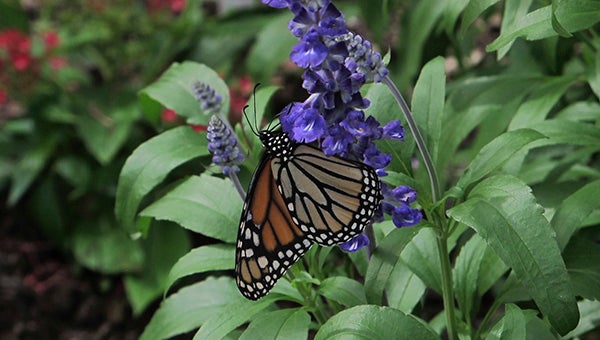Arboretum Paths: Monarchs and milkweed
Published 7:00 am Wednesday, August 19, 2015

in flight: A monarch butterfly sips nectar from a Salvia plant, a good nectar plant for your butterfly garden.
Photo by Pat Drackett
Have you spotted a monarch butterfly lately? I was lucky enough to see two of these dancing beauties in a “pas de deux” on my trip to the MSU campus in Starkville last week.
Monarchs are the only butterflies that will make a two-way migration like birds do. The populations in Western North America will overwinter in California, and those in Eastern North America overwinter in the Sierra Madre Mountains of Mexico. Because these butterflies return to the same specific areas each year, the Mexican government has fortunately recognized the need to protect and restore the overwintering habitat, establishing forest preserves that have become popular ecotourism attractions where visitors can experience the amazing phenomenon of these butterflies returning to roost in huge numbers.
These incredibly small creature can travel 50 to 100 miles in a day, and it can take them up to two months to make a journey spanning up to 3,000 miles. During the warm part of year, monarchs have a normal lifespan of about five weeks, but the last brood that hatches in late summer to early fall will travel south to Mexico to overwinter, and live up to eight months.
The butterflies travel north from Mexico, arriving in the South between March and May, and lay their eggs on milkweed plants. The eggs in will hatch into caterpillars that will consume the leaves of the milkweed plants, later developing chrysalises that will yield butterflies and the cycle will begin again as the butterflies push further northward. Through tagging and monitoring the monarchs, researchers have learned that monarchs will return to the same tree branch where their great-grandparents overwintered the year before.
Monarch populations hit an all-time low in 2013-14. This January it was reported that recent winter population had increased by approximately 70 percent. Hopefully we will learn at the beginning of 2016 that this winter has brought an increase in numbers as well.
Articles and online sources point out that factors that have been contributing to the population declines include the recent years of extreme weather, loss of forest habitat in Mexico where the species overwinters, and elimination of available milkweed through managing U.S. lands for agriculture.
On Saturday, August 22, attend a program on “Monarchs and Milkweed” from 10 to 11 a.m. at the Crosby Arboretum.Learn how you can attract butterflies, particularly monarchs, to your yard in this program with Linda Auld, better known as “BugLady,” owner and operator of Barber Laboratories in New Orleans. Linda has raised over 105 species of butterflies and moths for 39 years and is currently leading a milkweed project in her area to help local schools install butterfly gardens.
An obvious solution to helping the populations continue to increase is to plant more milkweed, and each region of the country has its own species unique to that area. There are approximately seventy species of milkweed native to the United States, and about half of these are regularly used as monarch butterfly host plants. Some of these are very rare or best suited to their natural habitat, while others will do just fine in your home garden. We’ll have handouts at the program to help you identify the milkweed species suited for Pearl River County.
Two species of milkweed species are found in our south pitcher plant bog, fewflower milkweed (Asclepias lanceolata), and longleaf milkweed (Asclepias longifolia). Longleaf milkweed has purple flowers in spring, while the tall fewflower milkweed has bright red-orange summer flowers that tower above the savanna grasses.
When designing a butterfly garden, include host and nectar plants to maximize the number of butterflies you will attract. If you are lucky, your milkweed will become laden with the green chrysalises of monarch butterflies. These are amazing structures, and are trimmed with metallic gold dots. It is simply an awesome sight to watch a monarch chrysalis change from opaque green to clear, and the new butterfly emerge.
On Saturday, August 29, Dr. Juan Mata from the University of South Alabama in Mobile will lead a mushroom hunt of the Arboretum grounds from 10 to 11:30 a.m. Admission is free to members. The cost for non-member adults to the monarch or mushroom program is $5, and $2 for children under 12. Call the office at 601-799-2311 to sign up.
The Arboretum is open Wednesdays through Sundays from 9 a.m. to 5 p.m. and located in Picayune, off I-59 Exit 4, at 370 Ridge Road (south of Walmart and adjacent to I-59). For more information about our programs and events, see the website at www.crosbyarboretum.msstate.edu.
FOR FURTHER EXPLORATION: How can you tell the difference between a male and a female monarch butterfly? Look this up on your favorite Internet search engine and prepare to amaze your friends!
By Patricia Drackett





